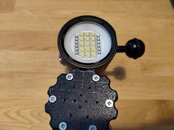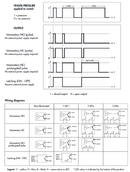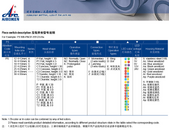Has anyone run into this issue? XTAR D26 2500, works for about half an hour, then brightness drops, the switch starts flashing red, and a few minutes later, it dies. The batteries are original XTAR-branded 26650s that shipped with the light, and testing them in a smart charger shows approximately 4950mAh capacity. In fact, removing them from the light and popping them in the charger after it has died shows that they've barely been discharged at all.
You are using an out of date browser. It may not display this or other websites correctly.
You should upgrade or use an alternative browser.
You should upgrade or use an alternative browser.
cheap chinese video light review
- Thread starter vovanx
- Start date
Please register or login
Welcome to ScubaBoard, the world's largest scuba diving community. Registration is not required to read the forums, but we encourage you to join. Joining has its benefits and enables you to participate in the discussions.
Benefits of registering include
- Ability to post and comment on topics and discussions.
- A Free photo gallery to share your dive photos with the world.
- You can make this box go away
davecampbell
Contributor
any updates on this? I've got 5 of the lights, and have experienced this occasionally. I'm not sure if it's a combination of what head, with what cell, and what tail cap I happen to be using together. They get mixed up from time to time... I've found very slightly unscrewing the tail cap, breaking the battery connection, can sometimes fix the issue... but do so at your own risk underwater. I'm going to try some different cells if I can find something good.Has anyone run into this issue? XTAR D26 2500, works for about half an hour, then brightness drops, the switch starts flashing red, and a few minutes later, it dies. The batteries are original XTAR-branded 26650s that shipped with the light, and testing them in a smart charger shows approximately 4950mAh capacity. In fact, removing them from the light and popping them in the charger after it has died shows that they've barely been discharged at all.
lermontov
Contributor
there doesnt seem to be a consistent correlation between price and reliability - ive had cheap chinese lights survive below 100m and more expensive ones fail at 20m
Does anyone have a good source (europe) for the Piezo switches which work with the lamp?
Should be NO Prolonged pulse. Or is there a workaround to use NO switch with short pulse?
Edit: Has anyone tried to replace the button with a reed switch embedded in epoxy?
Very hard to find on aliexpress, most only specify NO and "reset" but not if it's the prolonged pulse version which i assume is required to turn off the lamp without additional changes to the circuit.
Some measurements might help someone else
Button is M18x1mm thread.
17,8 to 17,9 mm outer diameter of the button
17,2 mm innerdiameter in the lamp.
The Button PCB is 14mm in diameter.
Depth to the first ledge in the housing (sealing surface) is 7 mm
Second level (below the PCB) is 10 mm
I have also made a tool to open the front and rear end of the lamp. An attempt for the button as well but the first version wasn't good enough so tweezer/thin pliers are recommended. See printables or thingiverse for details.

 www.thingiverse.com
www.thingiverse.com
Should be NO Prolonged pulse. Or is there a workaround to use NO switch with short pulse?
Edit: Has anyone tried to replace the button with a reed switch embedded in epoxy?
Very hard to find on aliexpress, most only specify NO and "reset" but not if it's the prolonged pulse version which i assume is required to turn off the lamp without additional changes to the circuit.
Some measurements might help someone else
Button is M18x1mm thread.
17,8 to 17,9 mm outer diameter of the button
17,2 mm innerdiameter in the lamp.
The Button PCB is 14mm in diameter.
Depth to the first ledge in the housing (sealing surface) is 7 mm
Second level (below the PCB) is 10 mm
I have also made a tool to open the front and rear end of the lamp. An attempt for the button as well but the first version wasn't good enough so tweezer/thin pliers are recommended. See printables or thingiverse for details.

Video light service tool by QRikard
I made this tool to simplify opening the front and rear of the video light for service and modifications. Apart from the printed part 12 screws are required. I used normal wooden screws with countersunk PZ2 head (7mm outer diameter of the head). This is important to fit into the lamp. The screw...
Attachments
Gone for diving
Contributor
Does anyone have a good source (europe) for the Piezo switches which work with the lamp?
Should be NO Prolonged pulse. Or is there a workaround to use NO switch with short pulse?
Edit: Has anyone tried to replace the button with a reed switch embedded in epoxy?
Very hard to find on aliexpress, most only specify NO and "reset" but not if it's the prolonged pulse version which i assume is required to turn off the lamp without additional changes to the circuit.
I think you mean latching.
I have found a few that latch on AliExpress, but its quite a while ago.
I think they are 3 wire...
You also can get a latch module, which a pulse switch can signal
No Latching is different. That's a 3 wire connection and means that the button will stay pressed until pushed again.I think you mean latching.
I have found a few that latch on AliExpress, but its quite a while ago.
I think they are 3 wire...
You also can get a latch module, which a pulse switch can signal
What i want is one of the piezo sensors which is short circuit while the button is pushed (up to 30 s). This means that i can make both a long and short pulse depending on how long i press the button. Just like with the original mechanical button on the lamp (perfect replacement).
These are available with 2-wire connection just like the piezo buttons that have a fixed dutycycle (usually between 50 to 300 ms).
If the pulstime is maximum 300 ms i won't be able to turn the lamp off using the button. Since it requires long press (3 seconds?)
See attached image from apem.com and PBA series datasheet, they have a NO prolonged version as well. Purchasing these is not as easy. Some prices went into 100 euro/button in some stores.
The aibeiken image is from one of the sensors that sells on aliexpress but they only have the NO and Latching version and not the K version which i want (NO prolonged).
I'm looking into reed relays, that should be a simpler and cheaper solution to cover on of those in epoxy and just make a sliding magnet.
Attachments
I have two of these light coming this week. I'll look into changing the switches to magnetic/hall switch models.
I have also access to a lumen meter (integrating sphere) and a light spectrum meter. I'll measure the true lumens and colour temperature.
I have also access to a lumen meter (integrating sphere) and a light spectrum meter. I'll measure the true lumens and colour temperature.
I received two lights from AliExpress. The order model was AS27-1H but the instruction manual says Sealion-B15. It was sold as a 20000lm light. 12000lm disappeared as soon as I opened the instruction manual. The manual states 8000lm. The brand is LetonPower. Other brand option was BRETT but I went with LetonPower because photos of it showed a brass ring on the PCB for positive battery contact. I don't like plain ENIG plated PCB for contact.
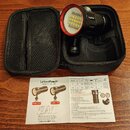
The first thing I did was adding a plastic stick to the head to prevent the PCB from rotating. I just glued it into place with hot glue and cut to proper length.
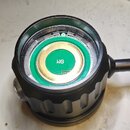
I have access to a dark room lab at work.
There I measured the spectrum of the light and colour temperature. From the spectrum I could calculate the CRI. The leds are cheap chinese leds with colour temperature of 7200K and CRI of 67.
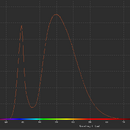
I also measured the leakage current in off state. It was only 17uA which is very good.
I ordered a third light which I will use for measuring the led driver circuit and for prototyping a magnet+hall switch upgrade for the buttons.
I will also measure the lux and lumen output of the lights. I have access to an integrating sphere lumen meter but I don't know the correction factor to the reading (lux meter reading to lumens). I'll probably measure the lux reading across the light pattern and calculate lumens of it.

The first thing I did was adding a plastic stick to the head to prevent the PCB from rotating. I just glued it into place with hot glue and cut to proper length.

I have access to a dark room lab at work.
There I measured the spectrum of the light and colour temperature. From the spectrum I could calculate the CRI. The leds are cheap chinese leds with colour temperature of 7200K and CRI of 67.

I also measured the leakage current in off state. It was only 17uA which is very good.
I ordered a third light which I will use for measuring the led driver circuit and for prototyping a magnet+hall switch upgrade for the buttons.
I will also measure the lux and lumen output of the lights. I have access to an integrating sphere lumen meter but I don't know the correction factor to the reading (lux meter reading to lumens). I'll probably measure the lux reading across the light pattern and calculate lumens of it.
Similar threads
- Replies
- 0
- Views
- 317
- Replies
- 44
- Views
- 5,372
- Replies
- 17
- Views
- 1,902



